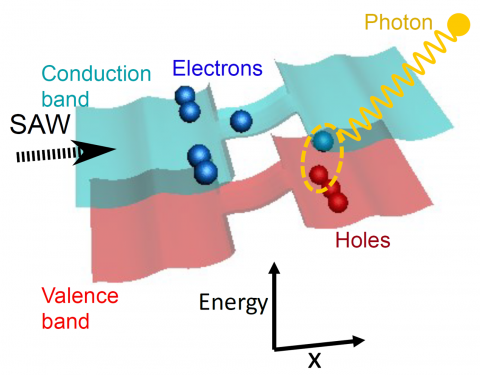We have developed a novel technique for generating single photons, by moving single electrons in a specially designed light-emitting diode (LED). This technique, reported in the journal Nature Communications (Hsiao et al., Nat. Commun. 11, 917 (2020), full text available here), could help the development of the emerging fields of quantum communication and quantum computation.
A single photon, the elementary particle of light, can carry a quantum bit of information over hundreds of kilometres. Therefore, a source that can generate single photons is an important building block in many quantum technologies. Up to now, single-photon sources have been made in research labs from self-assembled quantum dots in semiconductors, or structural defects in diamonds. The formation of these dots and defects is a random process, so it is hard to predict the location and the photon energy (or wavelength) of these single-photon sources. This randomness may pose a challenge in integrating a source into a large quantum network.
We have shown that we can generate a single photon in a different, controlled, way, without the need for a quantum dot or a defect, by moving only one electron at a time to recombine with a ‘hole’ (a missing electron in a filled ‘band’ of electrons).
Imagine trying to send a digital message by firing a stream of blue or red balls over a wall in the following way. A conveyor belt with ball-sized indentations drags a series of white balls up a slope and drops the balls off a cliff at the end. Each ball picks up speed as it falls, is then sprayed blue or red (depending on the message) as it bounces off to the side and over the wall. The indentations in the conveyor belt can only carry one ball each. Only one ball gets sprayed at a time, and there's no chance some of the balls are intercepted by an eavesdropper without the person on the receiving end noticing a missing ball, whereas if sometimes two or more balls come at a time, the eavesdropper can catch odd balls and the receiver is none the wiser. In that way, some of the message may be unintentionally disclosed.
In the experiment, we made a device near the surface of Gallium Arsenide (GaAs) by using only industry-compatible fabrication processes. This device consists of a region of electrons close to a region of holes, and a narrow channel in between.

Figure 1 Single electrons take a conveyor belt driven by a sound wave, and then recombine with holes to generate single photons one by one.
In order to transport only one electron at a time, we launch a sound wave along the surface. In GaAs, such a ‘surface acoustic wave’ also creates an accompanying electrical potential wave, in which each potential minimum carries just one electron. The potential wave, like a conveyor belt, brings individual electrons to the region of holes one after another. A series of single photons is generated when each electron quickly recombines with a hole before the next electron arrives.
Each single photon could be given one of two polarisations to carry a message such that an eavesdropper cannot intercept the message without being detected.
Figure 2. Animation showing how single electrons recombine with holes to produce single photons. It is also available at https://youtu.be/fOX6dh1L8Jk .
In addition to being a novel single-photon source, more importantly, it may be possible with this new technique to convert the state of an electron spin to the polarisation state of a photon. By bridging semiconductor-based quantum-computers using single photons as ‘flying’ qubits, the ambitious goal of building large-scale distributed quantum-computing networks may be achieved.
The work was carried out by a team including Tzu-Kan Hsiao, Antonio Rubino, Yousun Chung, Seok-Kyun Son, Hangtian Hou, Jorge Pedros, Ateeq Nasir and Richard Phillips, and the team was led by Chris Ford.
